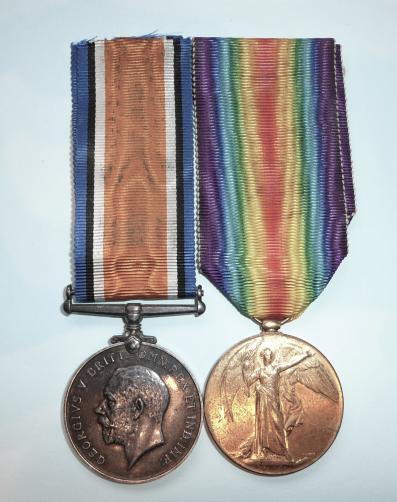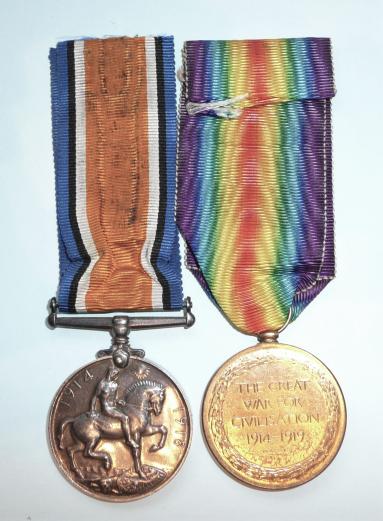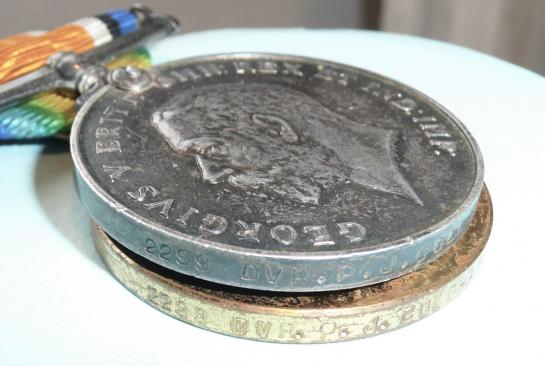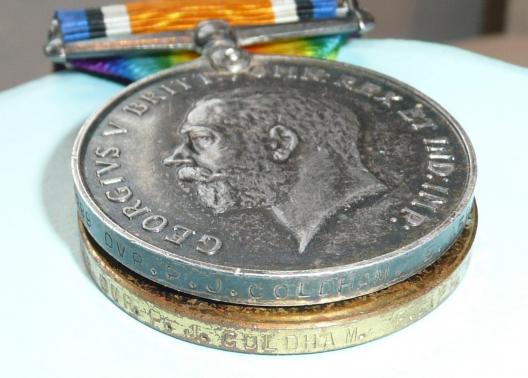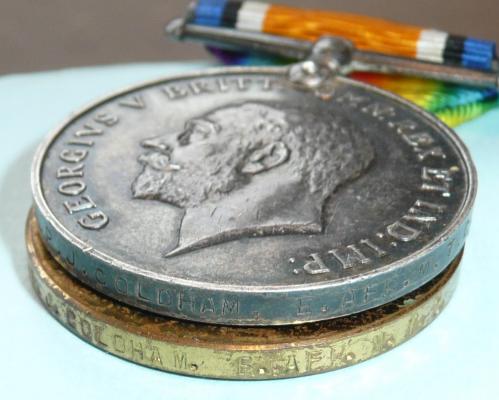WW1 Pair to East African Mechanical Transport Corps, Army Service Corps - Philip J. Coldham
A British War Medal and Victory Medal Pair with original ribbons and both correctly impressed to:
2299 Dvr P.J. Coldham E. Afr. M.T.C.
In GVF condition, a few light contact marks to BWM from the VM and the BWM dark toned. BWM ribbon a bit grubby and cut shorter than the VM ribbon. To be supplied with a copy of his medal index card which confirms his medal entitlement and these details. You can also view this here:
https://discovery.nationalarchives.gov.uk/details/r/D1870196
The corps only came into being from 1916 when the campaign in East Africa was re-invigorated with the sending of South African troops.
During WW1 in the East African campaign, the British used the earliest cars and trucks to good advantage whenever possible. Ford light cars, capable of carrying 300 pounds of cargo, had an immense advantage over porters as they required only a driver and were capable of much greater effort. The cars did require petrol, were subject to breakdown on the very difficult tracks, and the drivers were as vulnerable to disease and fatigue as the porters. Furthermore, in the rainy season the vehicles were incapable of negotiating the flooded swamps or the surrounding mud and in the dry season the collapse of the roads into fine dust caused considerable difficulties. However, the sheer efficiency of mechanical versus human transport soon made the motor vehicle an essential part of the British supply system; it has been estimated that one lorry was the equivalent of 30 porters. The limits on their use were the speed at which usable tracks could be cut, the provision of sufficient vehicles and drivers, and keeping the system working under the baleful influence of the climate and pestilence. In the final analysis, the motor vehicle was a significant factor in keeping the British advance going, particularly when the supply of porters withered in late 1917. By contrast, apart from the two railways, the Germans began the war in East Africa with only three motor vehicles. By September 1916, all of these mechanical means had been lost and they were almost completely reliant on porters.
As with the other areas of administration, there is considerable evidence that the British did not make best use of the available resources. From the onset of the advance in early 1916, out of six MT companies provided to the East African Expeditionary Force, one was allocated to a naval kite balloon section, four were attached to the artillery and only one was actually under the control of the Director of Supply and Transport. The problem of ever-expanding lines of communications also impacted heavily on the EA MTC, as divisional or column, it was not until Hoskins assumed command that a thorough reorganisation of the MT was undertaken. Recognising the inflexibility of the system, all vehicles were gradually placed under central control and allocated according to the size of the column to be supported. By August 1917, there was a single MT unit that supplied all aspects of the East African force and it was to be the mainstay of the organisation for the remainder of the war.
Source for the above: http://theses.gla.ac.uk/5195/1/2001AndersonPhD.pdf accessed 4th March 2020
The following gives a sense of the hardships endured by the members of this corps:
https://gweaa.com/home/medical-project/medical-archive/ includes a report by a Dr Pike (The Pike Report) into conditions in British and German East Africa. The extract below is from his report in relation to the drivers of the East African MTC:
"No body of white troops has suffered more, from the hardships of the campaign, than the Motor Transport drivers. These men have nearly always had to be overworked owing to the pressing needs of the force they served, the sickness amongst themselves, and the shortage of reinforcements. They are often on the road by daybreak, and are fortunate if their labours terminate at sunset. They have to drive over roads which are never good, and are often dangerous. They are exposed to the heat by day, and have often to sleep on the road in their cars, a frequent cause of chills. They may not be able to use their nets, and so get malaria at the same time. In certain areas they are constantly bitten by tsetse flies. They get their food where and when they can, and too often drink any water which may be available although warned not to do so.
These things being so, the absolute necessity of doing everything possible to improve the conditions under which these men have to work, and to preserve their health should have been apparent at an early date.
We saw them and travelled with them in the third year of the campaign, and we can only say that we found an absence of any proper system for dealing with the problem.
No attempts had as a general rule been made to provide tents or bandas for messes in these men’s camps, they had no facilities for ablution beyond their individual basins, towels, and soap. Nowhere did we find arrangements whereby they could wash their dirty clothes in a cleanly and agreeable fashion. Their sanitation was as a rule neglected, the latrines uncomfortable, and the receptacles uncovered. When on their return journeys they carried sick, they could usually manage to get hot food or hot drink at the wayside halts. At other times they had to go without, unless they had time to cook or to make tea themselves.
We do not wish to underrate the difficulties of the situation, but we are of opinion that many of these difficulties might have been obviated, and if the matter had been taken in had from the first a great deal would have been done to safeguard this important branch of the service, provided always that there was adequate supervision and that discipline was enforced."
There follows a letter sent by Dr Pike to the Deputy-Adjutant and Quartermaster-General in November 1917, after his inspection, pointing out what was considered essential to lessen the high sick rate of this class. See:
https://gweaa.com/home/medical-project/the-pike-report-on-german-east-africa/Section7
D73.1
Code: 61104

